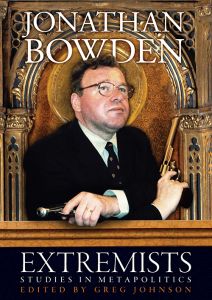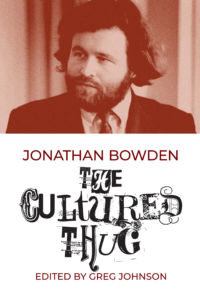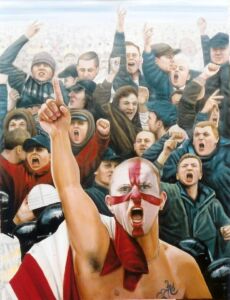There Ain’t No Black in the Union Jack
Posted By Mark Gullick On In North American New Right | 2 CommentsEnglish football fans in Europe during the 1980s and ‘90s were not ambassadors either for the British game or Britain itself. Increasingly cheap flights across Europe meant that vast numbers of fat, pasty, sweaty, bald or balding men were able to enjoy spoiling the afternoons of those wishing to use cafés and bars in Portugal, or France, or Malta.
Whenever England or a top English side played in Europe, a town square somewhere would soon fill with beer bellies on shirtless, gross, and grubby torsos. The gate was opened, and in lumbered a herd of gormless, chanting, hairless, sweaty fatsos with tattoos that showed a Union Jack with the legend “These colours don’t run” or “There ain’t no black in the Union Jack.” They would bring a deep sigh of despair to the most ardent White Nationalist. “Oh,” an advocate of a white ethnostate might say on seeing these beasts of the field. “I didn’t realize we were doing this for them as well.” The ability to qualify for citizenship in a white ethnostate is, however, a topic for another day. Back to our British diplomatic corps. They also used to chant, “No surrender to the IRA (Irish Republican Army),” but probably missed the bit where Tony Blair did just that.
These men were a disgrace, but sometimes you need to draw back from your disgust and ask why it is that you are disgusted. Now, the malevolent English football fan — most are fine, and many are very good company — is what novelists used to call a “rum character.” I’ve seen many in action from my days of going to Highbury, then the home of my club, Arsenal. One story suffices to explain the mental landscape to which I refer.
A stalwart drinking partner and I were in the beer garden of a pub just across from the football ground of Crystal Palace, the south London team with the most poetic name in the English top flight, along with Aston Villa. I digress. On this rare sunny English day, the beer garden began to fill up with away supporters. Bradford City, if I remember. Certainly they were very northern by the accents.
Me and my oppo stayed for an hour (you can’t walk out of that without looking like old women), and during that time one of the big Bradford supporters drank three pints of lager. Fair play; I’ve done four in an hour, and Guinness at that. But it was what he did with the glass at the end of every measure, which was to bang it down on the wooden table between me and my mate. He didn’t look at us, just banged the glass down, hard, on the table between us. When we left we didn’t look at any of them. There are men whose eyes you don’t meet unless you are ex-army, martial-arts trained, or another nutter. I don’t imagine there are as many of these hardcores around anymore. Surveillance has moved on.
Nowadays, football clubs ban their fans because of tweets. Back then, one fat man with no shirt looks much the same as another on a fuzzy CCTV recording of a post-match brawl. It is literally a different ball game. And my hunch is that there is a police unit somewhere, available if deep-Googled, who are watching English football fans very, very closely indeed, on- and offline. To brand football fans as “far Right” would be an optics coup. Football is increasingly white men watching black men play the game.
Thus, we might say that football fans and the trouble they caused were imposed on the non-football-supporting, non-riotous, relatively tranquil people who have to suffer their testosterone-fueled temper tantrums. “Soccer hooliganism” used to be the only time the mainstream media ever used the Americanism “soccer” to describe the game. It was as though the BBC wanted to distance themselves from all this beastliness by making it somehow America’s fault.
But soccer hooliganism is now vanishingly rare in the United Kingdom, nothing like the pitched battles between fans in the 1970s. Instead, a new type of hooliganism has been imposed, specifically on the white British and backed by a blatant media campaign of flagrant anti-whiteness. It is one tine of a three-forked trident, as we shall see. But first, let’s visit the leafy suburbs of England. Down on the border of Kent, the county dubbed “the garden of England” . . .
If you were to find yourself working in the UK as a location scout for a film company, and your boss had tasked you with finding somewhere typical of suburban London, Shortlands would be near the top of your wish list. But while “leafy” is the go-to term used to describe the suburbs of southern England, “risky” is coming up on the rails.
Last week, two men boarded a train at Shortlands station that was en route to London’s Victoria Station, the capital’s main transport hub and a large part of the reason for the rise of the south London suburbs. These were areas in which workers in the capital could make a separate piece, away from the urban grind they need only visit, work in, and then leave again for home. I grew up in a London suburb — a pleasant, relaxed, and very white town — and the attraction remains. For now. These towns were sub-urban, below the urban, and all the better for it. That may be coming to an end.
 [2]
[2]You can buy Jonathan Bowden’s Extremists: Studies in Metapolitics here [3].
The two men getting on at Shortlands were already fighting when one of them produced what is being termed a “zombie knife [4].” He repeatedly stabbed his victim, who cannot be seen on the video [5]. The man being stabbed is, at the time of writing, “hospitalized with life-threatening injuries.” Watch the thrusts of the blade, during which the clearly black attacker hesitates to select his next point of entry, and you will see that only the expert attention of (probably white) surgeons could save this man.
This grabbed media attention precisely because it took place in the suburbs, violent crime being linked in the modern mind with the urban. It may be that, like cities themselves, crime is beginning to sprawl outwards, away from the center. Blacks are starting to realize that there is even less effective policing outside of London than there is in the capital itself. There also remains the possibility that London’s black gangs are finding the heat turned up in their favored drug trade now that the Albanians are in town, having been preceded by their reputation for extreme violence. Blacks are unlikely to be as keen on fighting with them as they would be on running some 16-year-old to ground before butchering him.
I wrote on a weblog some 20 years ago that young black men in big cities were “Blair’s shock troops,” and I’ll stand by that. Their dominance in crime statistics cannot be the result of incompetent policing or inept government policy. Shortcomings may be dressed up to look that way, but the whole phenomenon of black crime is another phase in a program of destabilizing white culture using anarcho-tyranny. This is Project Fear [6], but staged on the streets and in the trains.
Blacks are useful for keeping white people just scared enough in public spaces, but it has also been obvious for the last three years that culture is being super-saturated with black faces, another way in which blacks are forced into white spaces and environments.
It has long been noted that the presence of specifically black faces in films, TV dramas, and advertisements has recently jumped disproportionately, and as Jared Taylor told me recently, such accounts are “ten a penny.” But it is instructive to revisit the recent televisual past to see how things have changed so much so quickly.
I often revisit Britain virtually when I have finished my working day in the form of old comedy or drama shows from my youth. The other evening, I discovered an old 1990s detective drama I had never heard of, but I remembered the actor Clive Owen — who became known in the United States not least for his CGI-assisted role in 2005’s Sin City — from the excellent 1980s series Chancer, and thought I would give it a go.
It was rubbish, but rubbish is what you need after a day of reading about Western politics. At least TV dramas don’t pretend to be in any way connected to reality. But something interested me about Sharman’s second episode. [7] It was made in 1996, when affirmative action in British drama was restricted to some light reggae in the incidental music and the occasional black secretary. In this, the good guys and girls were white British, the bad guys were black and Greek.

The script comes across as though it was written by a 17-year-old with mild learning disabilities, but that’s not the point. Had you pitched that same script to a production company ten years ago, they would have turned you down and never touched you again with a long pole. If you pitched it today, and you were white, they might well call the police.
Film and television are now dedicated to the glorification of blacks and the concomitant denigration of whites. But blacks are not only unleashed on the streets and boosted on the screen. Affirmative action is getting into gear, monitored and dictated, in the workplace.
The Financial Services Authority [8] (FSA) is a non-governmental body set up to “[regulate] financial firms providing services to consumers and [maintain]the integrity of the financial markets in the United Kingdom.” It focuses on “the regulation of conduct by both retail and wholesale financial services firms.” As of September 2023, the FSA has expanded its remit [9] in a manner ostensibly designed to “support healthy work cultures, reduce groupthink and unlock talent.” This is to be achieved by requiring financial services firms to submit annual employment figures reflecting their diversity.
Nikhil Rathi, the FSA’s CEO, justifies the move in a way that does not immediately explain the role of diversity statistics in the FSA’s operations: “For UK financial services to be competitive and for the companies in it to be well run with healthy work environments, it’s vital they attract, retain and promote the best talent.”
 [10]
[10]You can buy Jonathan Bowden’s collection The Cultured Thug here [11].
This is hard to gainsay. But meritocracy already ensures that. How does the publication of figures relating to the ethnic makeup of a company’s employees tend to improve this mission statement?
What this means, in effect, is that a regulatory body — the biggest in the industry — has now expanded its remit. Instead of regulating financial probity, it will now operate a corporate version of the Chinese social credit system to ensure more blacks and fewer whites in the workplace, which just got that much worse for whites. Make friends with your new black office mate, by all means, but be careful. That’s not the type of care you have to take when deciding where to sit on a suburban train, but it is linked by the white British experience of blackness. And this experience is actively supported by the British media.
As always, the mainstream media see their job as public relations for blacks. Ethnicity is mentioned as little as possible in crime stories, and an illegal immigrant committing a crime in Bristol, say, will be described as “a Bristol man.” Ethnicity is discounted as a causal factor. But anyone who has used London’s streets knows race is a crucial factor in the level of threat present. You just aren’t going to get mugged by a Sikh, carjacked by a Mennonite, or stampeded in a mall by a gang of feral Chinese kids. Blackness means dysfunction wherever it dominates demographically but, as people used to say, that’s “not something said in polite society.” It’s worth noting in passing that the word “polite” has the same root as the word “police,” which makes for an easy transition to “not something said in policed society.”
Media bias used to screen black violence can be simple, as with this piece from The Guardian [12] in February 2023. The headline informs us that “[b]lack people four times as likely as white people to be murdered, ONS data shows.”
The piece unpacks this data from the government’s own Office for National Statistics, but at no point mentions the ethnicity of the murderers, who are after all the other half of the equation that produces the data. The subtextual hint is that these dead black people were killed by whites. This is not the case. We would have heard something.
A feature in The Daily Telegraph [13] from December 2023 has a helpful hint beneath the headline, which reads “London knife and gun crime surges amid gang warfare.” Now, it is axiomatic that the feature will not mention blackness, and it does not, but the newspaper extends to its readers an invitation to “[f]ind out how much knife crime is in your area using our searchable tool.” They say there’s an app for everything, and now there is one for black dysfunction. Alternatively, rather than bother with the app, you could just walk out of your front door, stroll around for a while (if this is safe and it is daylight), count how many black people you see, and use that as a reliable basis for your estimation of the dangers inherent in where you live. You don’t need an app to recognize what Paul Kersey [14] calls “the black undertow.” The ship HMT Empire Windrush, which carried the first wave of Jamaican migrants to Britain, eventually brought with it a wave of black violence.
As a matter of fact, the Jamaicans who chose a better life in Britain when the ship docked at Tilbury in 1948 chose well. When Jamaica was granted independence in 1962, the murder rate in the country was 3.9 per 100,000 people. By 2022, at the height of Black Lives Matter activism in the UK, that figure had leapt to 53.34 murders per 100,000 people, making it one of the world’s most dangerous nations.
So, then, the three impositions. Blacks are increasingly present in white spaces — unasked for, unwanted, and with deleterious effects. On the streets, our screens, and the workplace, from bloody suburban knife fights to the plushest boardrooms, and from the blandest and slickest newsrooms to the latest costume drama featuring blacks playing historically white parts, the white British (and particularly English) experience is being super-saturated with blackness.
Soccer hooliganism died its social Darwinian death, but then soccer hooliganism was not supported by the government and sponsored by the media. White British citizens can now, like Henry Ford’s cars, have their cultural experience in any color they like as long as it’s black. In the office, on TV, and even on the train, there is now plenty of black in the Union Jack.
